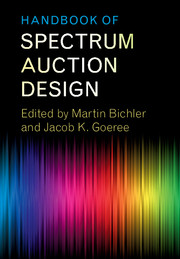Book contents
- Frontmatter
- Contents
- List of Contributors
- Preface
- List of Papers
- Part I The Simultaneous Multiple-Round Auction
- Part II The Combinatorial Clock Auction Designs
- Part III Alternative Auction Designs
- Part IV Experimental Comparisons of Auction Designs
- Part V The Bidders’ Perspective
- Part VI Secondary Markets and Exchanges
- Outlook
- References
Outlook
Published online by Cambridge University Press: 26 October 2017
- Frontmatter
- Contents
- List of Contributors
- Preface
- List of Papers
- Part I The Simultaneous Multiple-Round Auction
- Part II The Combinatorial Clock Auction Designs
- Part III Alternative Auction Designs
- Part IV Experimental Comparisons of Auction Designs
- Part V The Bidders’ Perspective
- Part VI Secondary Markets and Exchanges
- Outlook
- References
Summary
Make things as simple as possible, but not simpler (Albert Einstein)
Introduction
From 1994 to 2008, spectrum was sold almost exclusively using the Simultaneous Multiple Round Auction (SMRA). The SMRA is based on simple rules, which make it easy to explain and implement, yet they create considerable strategic complexity. Since items have to be won one-by-one, bidders who compete aggressively for combinations of items risk paying too much if they ultimately win an inferior subset. This exposure risk suppresses bidding with adverse consequences for the auction's efficiency and revenue.
Since 2008, regulators worldwide have adopted the Combinatorial Clock Auction (CCA) to avoid exposure problems. The CCA is based on very complex rules, but the premise was that bidding would be “straightforward,” i.e. bids would truthfully reflect valuations. Unfortunately, it is now well known that the CCA admits many other behaviors, including demand reduction, demand expansion, and predatory bidding (see Chapters 15–17). In particular, the CCA's supplementary stage may provide bidders with an opportunity to raise rivals’ costs, which has led to some hard-to-defend outcomes.
In light of recent experiences with the CCA, regulators should be reassured about the advantages of combinatorial formats when synergies for adjacent geographic regions or contiguous blocks of spectrum are important. Market designers should beware of Einstein's advice and not regress to offering solutions that are too simplistic. Instead, they should take stock of two decades of field experience to pinpoint features essential to participating bidders and regulators. After all, spectrum auction design will only be truly successful if we are able to model their preferences correctly.
The standard paradigm in mechanism design assumes bidders with independent and private valuations, quasi-linear utility functions, and unlimited budgets, and regulators who aim to maximize efficiency or revenue of an auction in isolation, i.e. ignoring its effect on the downstream market. While these assumptions result in models that are elegant, they are not necessarily relevant. In what follows, we discuss objectives of regulators and bidders in spectrum auctions and how they differ from these “textbook” assumptions. These differences have an impact on the choice of the auction format. Furthermore, we discuss challenges for future auction designs and requirements for new models.
Information
- Type
- Chapter
- Information
- Handbook of Spectrum Auction Design , pp. 903 - 911Publisher: Cambridge University PressPrint publication year: 2017
